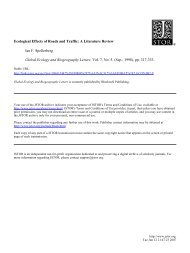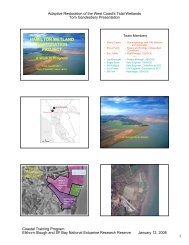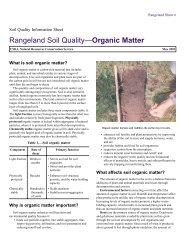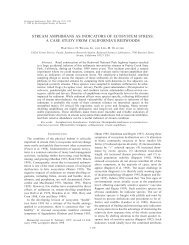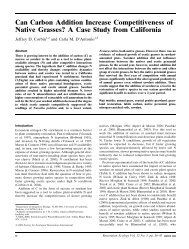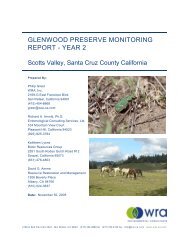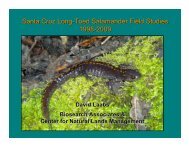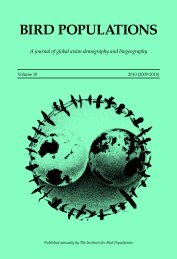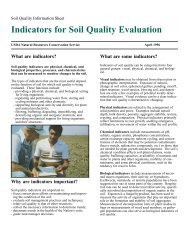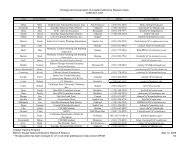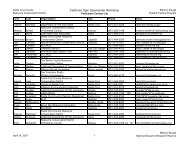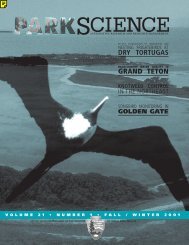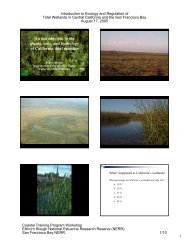Recreation and large mammal activity in an urban nature reserve
Recreation and large mammal activity in an urban nature reserve
Recreation and large mammal activity in an urban nature reserve
You also want an ePaper? Increase the reach of your titles
YUMPU automatically turns print PDFs into web optimized ePapers that Google loves.
BIOLOGICAL CONSERVATION 133 (2006) 107– 117 109of wildlife <strong><strong>an</strong>d</strong> hum<strong>an</strong>s <strong>in</strong> order to determ<strong>in</strong>e their spatial <strong><strong>an</strong>d</strong>temporal <strong>activity</strong> patterns. We focused our <strong>an</strong>alyses on three<strong>large</strong> <strong>mammal</strong>s – bobcat, coyote, <strong><strong>an</strong>d</strong> mule deer – that occurredthroughout the Nature Reserve of Or<strong>an</strong>ge County <strong><strong>an</strong>d</strong>were potentially responsive to hum<strong>an</strong> disturb<strong>an</strong>ces.Forty-n<strong>in</strong>e camera sites were established along dirt roads<strong><strong>an</strong>d</strong> major game trails throughout the NROC, with each siteseparated by a m<strong>in</strong>imum of 750 m. Camera locations wererestricted to relatively concealed areas to reduce theft <strong><strong>an</strong>d</strong>v<strong><strong>an</strong>d</strong>alism. In regions considered high risk for theft, cameraswere placed <strong>in</strong> lock<strong>in</strong>g steel conta<strong>in</strong>ers attached to metalposts. In low risk areas, cameras were attached to <strong>an</strong><strong>an</strong>chor (tree, post, etc.), <strong><strong>an</strong>d</strong> secured to the <strong>an</strong>chor by acable <strong><strong>an</strong>d</strong> lock. Cameras were set to delay 3 m<strong>in</strong> betweensuccessive photographs, were equipped with a 35 mmauto-focus<strong>in</strong>g lens <strong><strong>an</strong>d</strong> <strong>an</strong> auto flash mech<strong>an</strong>ism, <strong><strong>an</strong>d</strong> haveshoot<strong>in</strong>g dist<strong>an</strong>ces of 0.35–6.00 m. Date <strong><strong>an</strong>d</strong> time (PacificSt<strong><strong>an</strong>d</strong>ard Time, PST) of photographs were automaticallyburned onto the negatives. Infrared sensors have a maximumdetection dist<strong>an</strong>ce of 18.3 m, with <strong>an</strong> optimal dist<strong>an</strong>ceof 0.3–9.1 m. Each camera was set for cont<strong>in</strong>uous actionthroughout the day <strong><strong>an</strong>d</strong> night, <strong><strong>an</strong>d</strong> was positioned fac<strong>in</strong>gthe road or trail to ensure documentation of associatedwildlife <strong><strong>an</strong>d</strong> hum<strong>an</strong> recreational <strong>activity</strong>. Data collection beg<strong>an</strong><strong>in</strong> June <strong><strong>an</strong>d</strong> ended no later th<strong>an</strong> February from 1999 to2001, <strong><strong>an</strong>d</strong> cameras were checked once per calendar weekunless site <strong>activity</strong> required them to be checked more frequently(shortest <strong>in</strong>terval was once per day). Each year acamera rema<strong>in</strong>ed at a site for <strong>an</strong> average of 53.6 nights(SD = 19.9, r<strong>an</strong>ge: 21–114 nights).An <strong>in</strong>dex of relative <strong>activity</strong> (RA) was estimated for eachcamera station by calculat<strong>in</strong>g the number of images of aspecies detected <strong>in</strong> a photograph divided by the numberof nights the camera operated at that station. We used RAas measure of the spatial displacement of wildlife species<strong>in</strong> response to hum<strong>an</strong> recreationists across the 49 camerastations. Although we did not <strong>in</strong>dividually identify <strong>an</strong>imals<strong>in</strong> photographs <strong><strong>an</strong>d</strong> thus c<strong>an</strong>not measure absolute densities,the camera <strong>in</strong>dex c<strong>an</strong> provide a useful measure ofthe relative <strong>activity</strong> of species at each sampl<strong>in</strong>g po<strong>in</strong>t (Cutler<strong><strong>an</strong>d</strong> Sw<strong>an</strong>n, 1999; Carbone et al., 2001). If multiple <strong>in</strong>dividuals(images) were captured with<strong>in</strong> a s<strong>in</strong>gle photograph,each <strong>in</strong>dividual (image) was counted s<strong>in</strong>gularly. Relative<strong>activity</strong> <strong>in</strong>dices for wildlife species conformed to theassumption of a normal distribution, whereas hum<strong>an</strong> <strong>in</strong>dicesdid not <strong><strong>an</strong>d</strong> thus were log tr<strong>an</strong>sformed <strong>in</strong> subsequent<strong>an</strong>alyses.2.3. Temporal displacement (percent daytime <strong>activity</strong>)For each target species detected, percent daytime <strong>activity</strong>(PDA) was calculated by collaps<strong>in</strong>g images taken 0600–1759(PST) <strong>in</strong>to a diurnal category <strong><strong>an</strong>d</strong> images taken 1800–0559(PST) <strong>in</strong>to a nocturnal category. This allowed for <strong>an</strong> overallestimation of PDA per species <strong><strong>an</strong>d</strong> at each site. PDA was calculatedper species only for sites with a m<strong>in</strong>imum of fiveimages. We used PDA as a measure of the temporal displacementof wildlife to hum<strong>an</strong> recreationists. The proportion ofdaytime <strong>activity</strong> was arcs<strong>in</strong> square root tr<strong>an</strong>sformed for statistical<strong>an</strong>alyses.2.4. Data <strong>an</strong>alysis2.4.1. Sub-region, season, vegetationPrelim<strong>in</strong>ary <strong>an</strong>alyses were conducted to evaluate the potentialeffects of sub-region (coastal <strong><strong>an</strong>d</strong> central <strong>reserve</strong>), season(wet <strong><strong>an</strong>d</strong> dry), <strong><strong>an</strong>d</strong> vegetative cover (trees, native shrubs, <strong><strong>an</strong>d</strong>exotic vegetation) on relative <strong>activity</strong> <strong><strong>an</strong>d</strong> circadi<strong>an</strong> <strong>activity</strong> ofwildlife <strong><strong>an</strong>d</strong> hum<strong>an</strong>s. Relative <strong>activity</strong> did not differ betweensub-regions for bobcats, mule deer, <strong><strong>an</strong>d</strong> hum<strong>an</strong>s (all t < 0.613,all P > 0.543), although RA was higher <strong>in</strong> the coastal subregionfor coyotes (me<strong>an</strong> coastal ± SD = 0.276 ± 0.234, n = 24;me<strong>an</strong> central = 0.160 ± 0.124, n = 20; t = 2.097, P = 0.043). PDAfor mule deer did not signific<strong>an</strong>tly differ between sub-regions(me<strong>an</strong> coastal = 0.412 ± 0.410, n = 16; me<strong>an</strong> central = 0.679 ±0.492, n = 16; t = 1.699, P = 0.105), however, PDA was higher <strong>in</strong>the coastal sub-region for bobcats (me<strong>an</strong> coastal= 0.731 ± 0.231, n = 11; me<strong>an</strong> central = 0.420 ± 0.278, n = 13;t = 2.945, P = 0.007) <strong><strong>an</strong>d</strong> coyotes (me<strong>an</strong> coastal = 0.500 ± 0.246,n = 19; me<strong>an</strong> central = 0.264 ± 0.233, n = 17; t = 2.950, P =0.006). To account for sub-regional effects <strong>in</strong> subsequent statistical<strong>an</strong>alyses of hum<strong>an</strong> recreational impacts, RA for coyotes<strong><strong>an</strong>d</strong> PDA for both coyotes <strong><strong>an</strong>d</strong> bobcats werest<strong><strong>an</strong>d</strong>ardized by tak<strong>in</strong>g the st<strong><strong>an</strong>d</strong>ard normal Z scores with<strong>in</strong>each sub-region.Although log tr<strong>an</strong>sformed hum<strong>an</strong> RA <strong>in</strong>dices tended to behigher <strong>in</strong> the dry season (me<strong>an</strong> dry = 0.385 ± 1.022, me<strong>an</strong>wet = 0.011 ± 1.245, n = 14 sites sampled <strong>in</strong> both the wet<strong><strong>an</strong>d</strong> dry season with<strong>in</strong> the same year; paired t = 2.085,P = 0.057), RA did not differ by season for bobcats, coyotes<strong><strong>an</strong>d</strong> mule deer (all paired t < 1.164, all P > 0.275) nor did PDAdiffer by season for these three target species (all pairedt < 1.154, all P > 0.292) <strong><strong>an</strong>d</strong> the majority (86%) of sampl<strong>in</strong>g occurreddur<strong>in</strong>g the dry season. Thus, season was not <strong>in</strong>cluded<strong>in</strong> further <strong>an</strong>alyses. Likewise, vegetative cover of trees, nativeshrubs <strong><strong>an</strong>d</strong> exotic vegetation did not differ between sub-regions(all t < 1.770, P > 0.083, n coastal = 24, n central = 24) orbetween areas of high <strong><strong>an</strong>d</strong> low hum<strong>an</strong> use (all t < 0.731,P > 0.473, n high = 14, n low = 34; see below for def<strong>in</strong>ition ofhigh <strong><strong>an</strong>d</strong> low hum<strong>an</strong> use sites). Further, prelim<strong>in</strong>ary tests revealedfew signific<strong>an</strong>t relationships between vegetative cover<strong><strong>an</strong>d</strong> RA or PDA of wildlife (George, unpublished data). Thus,vegetative cover was also not <strong>in</strong>cluded <strong>in</strong> further <strong>an</strong>alyses.2.4.2. Hum<strong>an</strong> recreationThe relationships between recreation <strong><strong>an</strong>d</strong> wildlife <strong>activity</strong>were assessed <strong>in</strong> multiple steps. First, logistic regressionswere performed to determ<strong>in</strong>e if overall hum<strong>an</strong> <strong>activity</strong> wasa signific<strong>an</strong>t predictor of the probability of a species us<strong>in</strong>g amonitored trail (for all 49 camera stations) as well as the probabilityof exhibit<strong>in</strong>g daytime <strong>activity</strong> at a site (for all stationswith a m<strong>in</strong>imum of five images for each species). For the logisticregression models, the response variable was <strong>in</strong>put asa 1 (or 0) if a species was detected (or not) at a camera stationor dur<strong>in</strong>g the day.Second, each camera site was categorized as either ‘‘high’’or ‘‘low’’ based on overall levels of hum<strong>an</strong> recreation. A visual<strong>in</strong>spection of the hum<strong>an</strong> RA distribution <strong>in</strong>dicated a naturalbreak at a camera <strong>in</strong>dex of about 4.0 (i.e. four images of recreationistsper sampl<strong>in</strong>g day), correspond<strong>in</strong>g to approximately30% of the most highly used sites by recreationists. This



